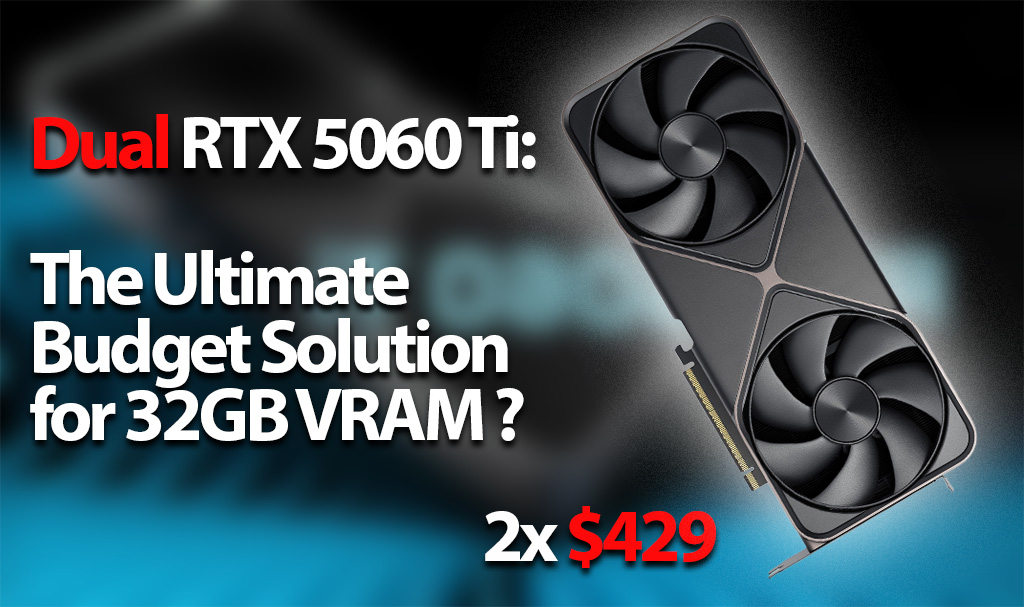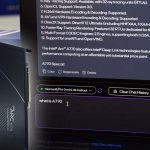Dual RTX 5060 Ti: The Ultimate Budget Solution for 32GB VRAM LLM Inference at $858

NVIDIA has officially unveiled the RTX 5060 Ti with 16GB of GDDR7 memory at $429, positioning it as a compelling option for local LLM enthusiasts. At this price point, the card not only offers excellent standalone value but opens up an even more enticing possibility: a dual-GPU configuration that rivals high-end solutions at a fraction of the cost.
Price-Performance Breakthrough for LLM Inference
The $429 MSRP represents an aggressive pricing strategy from NVIDIA, considering the specifications we reported earlier:
- 4608 CUDA cores
- 16GB of GDDR7 memory
- 448 GB/s memory bandwidth (55.6% higher than RTX 4060 Ti 16GB)
- 180W TDP
- PCIe 5.0 x8 interface
This puts the RTX 5060 Ti at just $30 more than the launch price of the RTX 4060 Ti 16GB ($399), while delivering substantially improved specifications across the board. For single-GPU LLM workloads, this already represents excellent value, but the real breakthrough comes when considering multi-GPU configurations.
Dual-GPU Setup: Accessing 32GB VRAM Territory
At $858 for two cards, a dual RTX 5060 Ti 16GB configuration enters a performance tier previously reserved for much more expensive solutions:
| Configuration | Total VRAM | Total Bandwidth | Approx. Cost | TDP |
|---|---|---|---|---|
| 2× RTX 5060 Ti 16GB | 32GB | 448 GB/s | $858 | 360W |
| RTX 3090 (Used) | 24GB | 936 GB/s | ~$1000 | 350W |
| RTX 4090 | 24GB | 1008 GB/s | $1599 ($3300+ April 2025) | 450W |
| RTX 5090 | 32GB | ~1700 GB/s | $1999 ($4000+ April 2025) | 560W |
While this dual-GPU setup can’t match the raw bandwidth of an RTX 5090, it provides sufficient VRAM capacity to run current 32B parameter models like QwQ in 4-bit quantization, with ample context length for reasoning-intensive tasks. The ability to spread these models across two GPUs using tensor parallelism in frameworks like llama.cpp creates a remarkably cost-effective solution.
Power and System Requirements
The relatively modest 180W TDP of each RTX 5060 Ti means a dual-GPU setup remains accessible from a power perspective:
- Total system power draw likely stays under 600W during full load
- An 800W PSU provides comfortable headroom
- Standard ATX cases with decent airflow should accommodate both cards
Implications for the Used Market
The RTX 5060 Ti’s compelling price-to-performance ratio is putting serious pressure on the inflated used GPU market. With dual 5060 Ti cards offering more VRAM at a lower cost, used RTX 3090s priced around $1,000 suddenly seem overpriced. As these newer cards hit the market, it’s likely that prices for alternatives like the RTX 4060 Ti 16GB will continue to decline. For budget-conscious enthusiasts hesitant to drop $858 upfront, this shift could open up new buying opportunities in the used market.
Real-World Performance Considerations
While the specifications paint a promising picture, several factors will determine actual performance in LLM workloads:
- Driver optimization for multi-GPU tensor parallelism
- Effectiveness of PCIe 5.0 in handling cross-GPU communication
For enthusiasts currently running 14B models who are looking toward the future of local inference with larger models, a dual RTX 5060 Ti setup represents an accessible path to 32GB VRAM territory. At $858, it undercuts other options while providing sufficient specifications for current-generation 32B models and likely many future releases.
As benchmarks emerge in the coming days, we’ll be closely monitoring how these cards perform in real-world LLM inference scenarios, particularly in multi-GPU configurations where their collective specifications could redefine what’s possible at the sub-$1000 price point.




